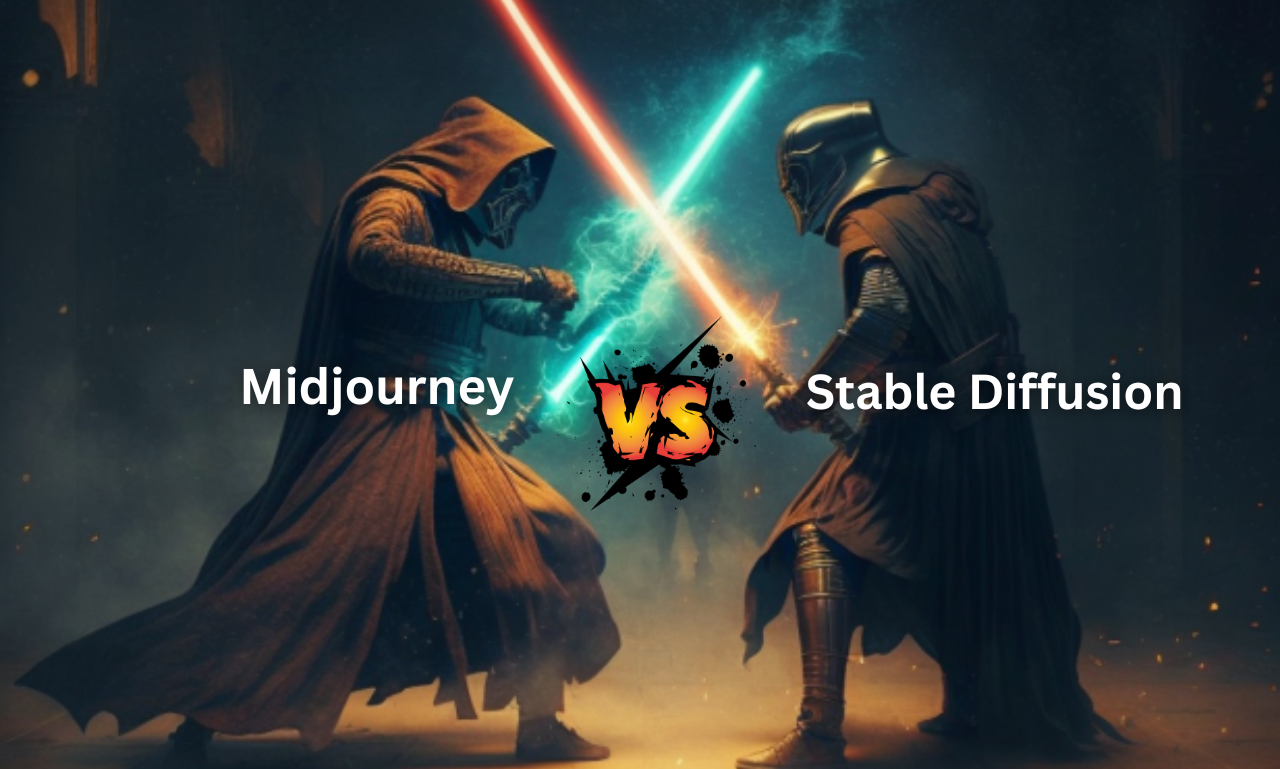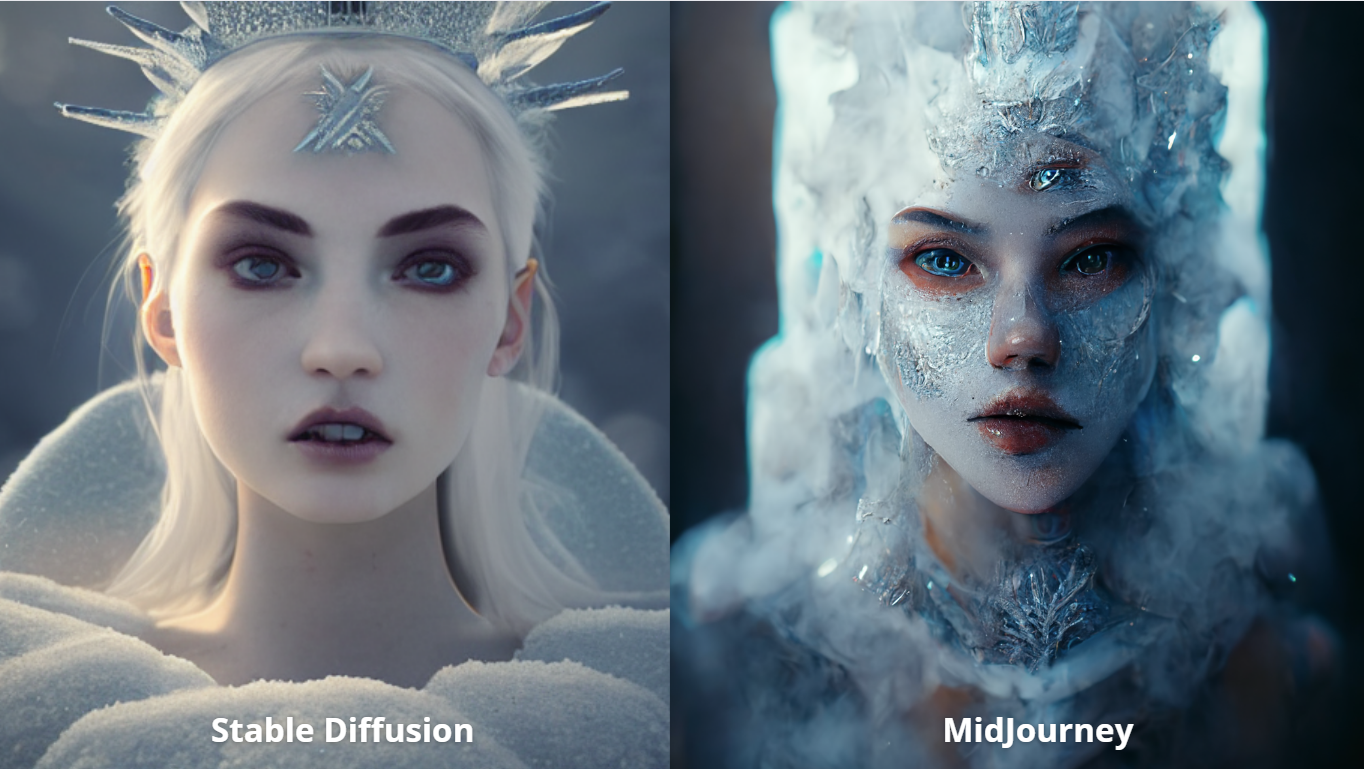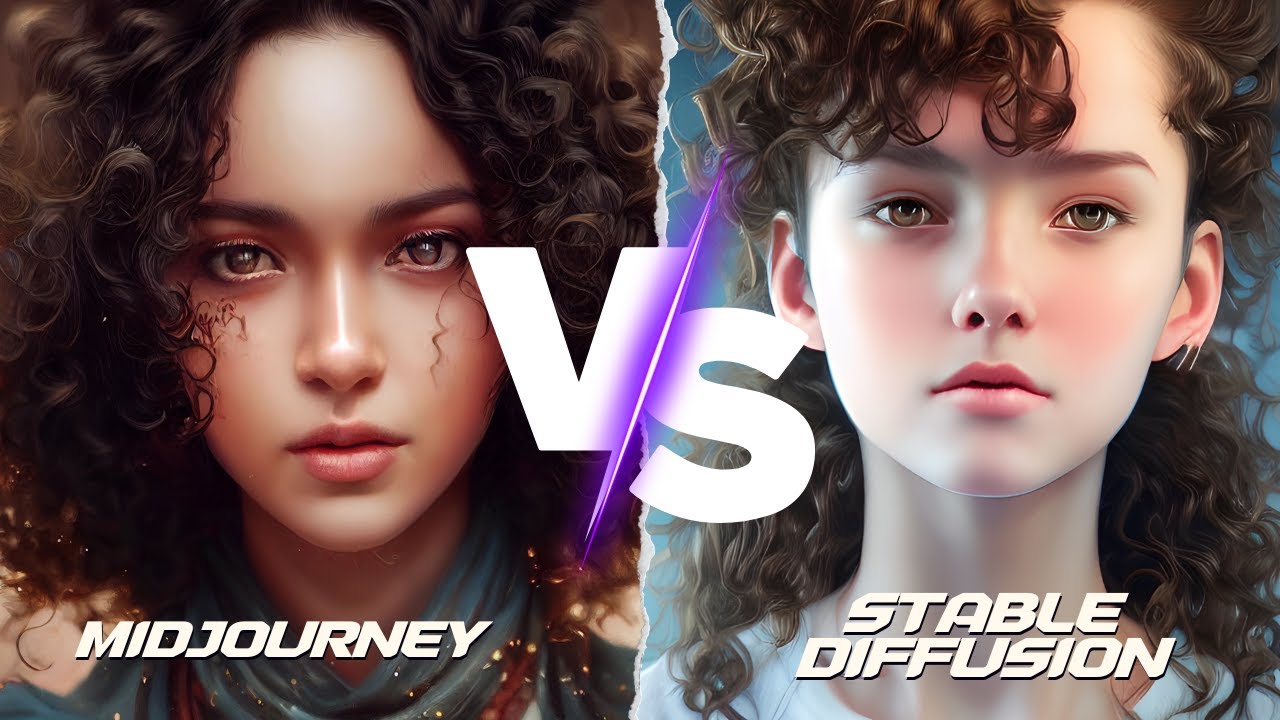
Midjourney vs Stable Diffusion comparison
Midjourney is a website service that uses words to create beautiful AI visuals.Although there are some distinctions, it is comparable to stable diffusion. Only available online, Midjourney has a cost associated with it. So, is Midjourney pricey enough to be worth it? How does it vary from stable diffusion, and why? Let's investigate.
Midjourney vs Stable Diffusion comparison
This section includes a thorough comparison between Stable Diffusion and Midjourney. Stable Diffusion can be used in several ways, unlike Midjourney. My analysis will be limited to utilising AUTOMATIC1111, a well-liked GUI for stable diffusion.
You can use AUTOMATIC1111 as a web service similar to Midjourney.ai. (e.g. Google Colab). You can also use it locally on Windows PC and Mac. Stable Diffusion is new to you? Take a look the Quick Start Manual.
The page contains numerous image comparisons. To improve the photographs, I adjusted the prompts and chose the right models in each situation. Thus, they are more like attempts to produce comparable images of different styles rather than direct comparisons of the same stimuli.

Comparison between MidJourney and Stable Diffussion table summary.
| Stable Diffusion (AUTOMATIC1111) | Midjourney | |
|---|---|---|
| Image Customization | High | Low |
| Ease of getting started | Low | Medium |
| Ease of generating good images | Low | High |
| Inpainting | Yes | No |
| Outpainting | Yes | No |
| Aspect ratio | Yes | Yes |
| Model variants | ~1,000s | ~ 10s |
| Negative prompt | Yes | Yes |
| Variation from a Generation | Yes | Yes |
| Control composition and pose | Yes | No |
| License | Permissive. Depends on the model used | Restrictive. Depends on the paid tier |
| Make your own model | Yes | No |
| Cost | Free | $10-$60 per month |
| Model | Open-sourced | Proprietary |
| Content Filter | No | Yes |
| Style | Varies | Realistic illustration, artistic |
| Upscaler | Yes | Yes |
| Image Prompt | No | Yes |
| Image-to-image | Yes | No |
| Prompt word limit | No limit | ? |
MidJourney and Stable Diffusion image modification
Stable Diffusion offers many options to alter an image, including the ability to alter the image's size, how closely the prompt should be followed, how many images are generated, the seed value, samplers, and more. In Midjourney, there are fewer options. The aspect ratio, the seed, and whether to quit early are all editable.
Conclusion Stable Diffusion triumphs.
Midjourney is Easy to Get Started
AUTOMATIC1111 is a bit hard to install. After you it up and running, you will still need to find and install models to get the styles you want.
Because they choose to use Discord as an interface, Midjourney is not as user-friendly as it could be. But getting started is still ten times simpler.
Conclusion :Midjourney triumphs.
Midjourney is Easy to generate good images
It's commonly known that Midjourney makes it shockingly simple to create beautiful photos with plenty of small details. To create quality photographs, you don't have to put in a lot of effort. In fact, it will frequently ignore a portion of your challenge and present unexpectedly beautiful visuals.
Conclusion: Midjourney triumphs.
Midjourney vs Stable Diffussion Prompt
Both Stable Diffusion and Midjourney support prompt and negative prompt. Both can add weight to any keywords in a prompt. You can do slightly more prompt tricks with AUTOMATIC1111, such as blending two keywords.
Conclusion: both triumphs .

Midjourney vs Stable Diffusion Models varieties
Midjourney is known for its photorealistic images. It can generate images that are indistinguishable from real photos, even with complex prompts. However, Midjourney is not as versatile as Stable Diffusion. It can only generate images from text prompts, and it doesn't support image-to-image editing.
Stable Diffusion is more versatile than Midjourney. It can generate images from text prompts, as well as from existing images. It also supports image-to-image editing, which allows you to modify existing images or create new images based on existing images. However, Stable Diffusion's images are not as photorealistic as Midjourney's images.
The comparisons of Midjourney's models are constrained. They provide models from version 1 to version 5, as well as a few unique models including niji, test, testp, and HD. There is a further parameter with which you can "stylize" the picture. But Stable Diffusion is dwarfed by the whole selection.
Conclusion: Stable Diffusion wins.
Midjourney vs Stable Diffusion Image editing
There are no image editing features in Midjourney. Only text questions can produce new images. This implies that you are unable to modify already-created photos or produce new images based on them.
Stable Diffusion includes a wide range of image modifying features. Editing already-created photos, building new images from them, and even remixing models to produce new styles are all options. As a result, Stable Diffusion is an extremely flexible image modification tool.
Sadly, you cannot edit an image with Midjourney.
Conclusion : Stable Diffusion wins.

Midjourney vs Stable Diffusion Style
The photorealistic photos that Midjourney uses to convey its own aesthetic. Even with complicated challenges, Midjourney's graphics frequently seem exactly like real photographs. Nevertheless, Midjourney is unable to produce various styles.
Compared to Midjourney, Stable Diffusion offers a more diversified aesthetic. Depending on the challenge, Stable Diffusion can produce anything from photorealistic to abstract visuals. Additionally, Stable Diffusion has the capacity to produce various styles by utilising various models. As a result, Stable Diffusion is a more flexible tool for producing images.
Stable Diffusion can generate a broader range of styles ranging from realistic photos to abstract art, thanks to the passionate community and ease of training new models. Users can remix models with embeddings, LoRAs, or hypernetowrks. It can produce surprising effects and is fun to play with.
Conclusion : Stable Diffusion wins.
Midjourney vs Stable Diffusion Variation from a generation
Both offers generate slight variations of a generated image. You press the V buttons under the images in Midjourney. You use the variational seed option in AUTOMATIC1111.
Conclusion both Midjourney vs Stable Diffusion Tie.
Midjourney vs Stable Diffusion Control composition and pose
Stable Diffusion and Midjourney both provide options for adjusting the composition and pose of created images. Stable Diffusion provides more adaptability and control, though.
By employing an image cue, Midjourney gives you the ability to control composition and pose. This indicates that you can supply a reference image for the composition and posing of the created image. However, this can be constricting because you are only allowed to use the photographs you already have.
Stable Diffusion offers a number of ways to control composition and pose, including:
- Image-to-image: This allows you to provide an existing image that you want to use as a reference for the composition and pose of the generated image.
- Depth-to-image: This allows you to provide a depth map that you want to use as a reference for the composition and pose of the generated image.
- Instruct-pix2pix: This allows you to provide a text prompt that describes the composition and pose of the generated image.
- ControlNet: This allows you to control the composition and pose of the generated image by using a control network.
The most adaptable and potent method for regulating composition and attitude in stable diffusion is ControlNet. You can adjust the items' position, rotation, scale, and even expression in the resulting image.
Compared to Midjourney, Stable Diffusion provides more freedom and control for adjusting composition and pose in created photos. Stable Diffusion is a preferable option if you require fine control over the arrangement and posture of your created images.
Conclusion : Stable Diffusion wins.
Cost
You can use AUTOMATIC1111 for free on your own PC to use stable diffusion. Using Midjourney, however, would cost you at least $10 each month.
Verdict: Stable Diffusion wins.
Midjourney vs Stable Diffusion License
A proprietary licence is used to distribute Midjourney. Because of this, you are only permitted to use the Midjourney model and the photographs it produces for your own personal purposes. You must secure a commercial licence from Midjourney in order to use the Midjourney model for profit. See their terms of service.
In contrast, Stable Diffusion claims no right. The MIT licence governs Stable Diffusion's licencing. Therefore, you may use the Stable Diffusion model and the images you produce using it for any purpose, including profitable ones. To use the model or the photos you create using Stable Diffusion, no licence is required from the software's creators.
opinion: Stable Diffusion wins.
Midjourney vs Stable Diffusion nsfw Filter
There is a content filter in the original Stable Diffusion v1 software, but the community quickly shared a version with the filter disabled. So in practice, there’s no content filter in the v1 models. v2 is trickier because NSFW content is removed from the training images. It cannot generate explicit content by design. In contrast, generating explicit images are off limit in Midjourney. It is blocked even at the prompt level. You can get banned if you try.
Conclusion : Stable Diffusion wins.
Also read MidJourney nsfw walkaroundMidjourney vs Stable Diffusion Making your own models
Both Midjourney vs Stable Diffusion allow you to make your own models. However, the process is different for each platform.
MidJourney You cannot directly create your own models in Midjourney. You can, nevertheless, come up with your own prompts and distribute them throughout the Midjourney community. Your prompts may be included to the Midjourney model by other users if they think they're helpful.
Stable Diffusion By training a diffusion model on your own collection of images, stable diffusion enables you to create your own models. Although it can be a difficult procedure, it enables you to make models that are customised to your particular requirements.
Here is a table that summarizes the key differences between making your own models in Midjourney vs Stable Diffusion:
| Feature | Midjourney | Stable Diffusion |
|---|---|---|
| Model creation | Not possible | Possible |
| Process | Share prompts with community | Train model on your own dataset |
| Flexibility | Limited | Flexible |
Conclusion: Stable Diffusion wins.
Upscaler
There are upscalers in both Stable Diffusion and Midjourney. upscalers. There are more options and settings accessible in AUTOMATIC1111. In fact, installing extra ones is simple.
Conclusion: Stable Diffusion wins.
Midjourney vs Stable Diffusion Image Prompt
Both Midjourney vs Stable Diffusion produce images using image cues. They do employ visual prompts, but in a different way.
The most effective technique to use picture prompts will ultimately rely on your particular needs. Stable Diffusion is a preferable option if you want to have precise control over the images that are generated. Midjourney might be a better option if you are unsure of how to use image prompts.
Opinion: Midjourney wins.
Image-to-image
Currently, there is no image-to-image feature in Midjourney that would enable diffusion models to produce images based on other pictures. This is hardly surprising considering that earlier versions of Midjourney might not have been diffusion models.
Opinion: Stable Diffusion wins.
Prompt limit
The user guide for Midjourney used to claim that the prompt had a word limit of around 60. However, they took that out. However, AUTOMATIC1111 now supports prompts of any length.
FAQs
Is Midjourney using Stable Diffusion?
Midjourney v5 model is not Stable Diffusion. That’s all they said. However, the improvements to v5 look suspiciously similar to Stable Diffusion v2: The prompt needs to be more literal and specific. People are getting five fingers… Could Midjourney share some components of Stable Diffusion v2, like the OpenClip text embedding? It certainly makes sense to use a diffusion model because of the lower run costs.
Is Midjourney better than Stable Diffusion?
Stable Diffusion is not used by Midjourney.ai. Midjourney has its own image generating model that is not made available to the general public. Nevertheless, there are some parallels between the images produced by Stable Diffusion and Midjourney. This is due to the fact that both models generate images using diffusion models.
A particular class of generative model called a diffusion model adds noise to an image progressively until it reaches the required level of realism. This contrasts with other generative models, such GANs, which create visuals from nothing.
Midjourney might be employing a diffusion model similar to Stable Diffusion, based on the similarity between the images it produces and those produced by Stable Diffusion. This hasn't been confirmed, yet.
Another possibility is that Midjourney is employing a separate diffusion model that was honed on a different set of visual data. This could explain why the images produced by Midjourney vs Stable Diffusion differ just a little bit.
How does Midjourney differ from Stable Diffusion?
AI image generators Midjourney vs Stable Diffusion both produce images using diffusion models. The two systems do differ in several significant ways, though.
The closed-source Midjourney platform is only accessible to a small number of users. Generally speaking, the images produced by Midjourney are more photorealistic than those produced by Stable Diffusion. Midjourney, however, costs more than Stable Diffusion.
Anyone can use the open-source framework known as Stable Diffusion. Compared to photos produced by Midjourney, those produced by Stable Diffusion are often less lifelike. Stable Diffusion, however, can also be used without cost.
The fundamental distinctions between Stable Diffusion and Midjourney are listed in the following table:
| Feature | Midjourney | Stable Diffusion |
|---|---|---|
| Platform | Closed-source | Open-source |
| Cost | Paid | Free |
| Image quality | Photorealistic | Less photorealistic |
| Flexibility | Limited | Flexible |
| Control | Limited | More control |
| License | Proprietary | MIT |
Generating a Midjourney image in Stable Diffusion
In Stable Diffusion, a Midjourney picture can be produced. It is not quite as simple as just entering the same prompt as you would in Midjourney, though.
This is due to the fact that Midjourney vs Stable Diffusion employ distinct diffusion models. Therefore, the prompts that function in Midjourney might not function in Stable Diffusion.
You must utilise a prompt created specifically for Stable Diffusion in order to create a Midjourney image in this model. There are many various prompts you can use, but some of the most well-liked ones are as follows:
- Image-to-image: This prompt allows you to provide an existing image that you want to use as a reference for the composition and pose of the generated image.
- Depth-to-image: This prompt allows you to provide a depth map that you want to use as a reference for the composition and pose of the generated image.
- Instruct-pix2pix: This prompt allows you to provide a text prompt that describes the composition and pose of the generated image.
- ControlNet: This prompt allows you to control the composition and pose of the generated image by using a control network.
Your particular demands will determine which prompt is best for you. The ControlNet prompt is the ideal option if you want exact control over the output image. If you're unsure which prompt to use, try a few different ones to determine which one suits you the best.
Midjourney vs Stable Diffusion both have a large user base. They have their strengths and weaknesses.
MidJourney ai is for you if
- You want to create photorealistic images. Midjourney is known for generating images that are very realistic. If you want to create images that look like they were painted or drawn by a human, then Midjourney is a good option.
- You want to have creative control over your images. Midjourney allows you to specify the content, style, and mood of the images that you generate. This gives you a lot of creative control over the final product.
- You are interested in the latest in AI technology. Midjourney is a cutting-edge AI platform. If you are interested in seeing what the future of AI holds, then Midjourney is a good place to start.
Stable Diffusion is for you if
- You want an open-source platform. Stable Diffusion is an open-source platform, which means that you can freely access the code and modify it to your liking. This gives you more flexibility and control over the way that the platform works.
- You want more control over the generated images. Stable Diffusion allows you to use a variety of prompts to control the content, style, and mood of the generated images. This gives you more control over the final output than other platforms that rely on simple text prompts.
- You want to use the model for commercial purposes. Stable Diffusion is licensed under the MIT license, which means that you can use the model for commercial purposes without any restrictions. This is not the case with all other platforms, which may require you to obtain a commercial license.
Conclusion
In understanding the distinctions between Midjourney and Stable Diffusion and choosing which to employ, I hope this post has been helpful. You should try both if you have the time and money to do so. Both will probably find a place in your process. I use both of them, and I frequently find the difficulty of creating one's images with the other to be fascinating.
